Nanofabrication of Bulk Diffraction Nanogratings via Direct Ultrashort-Pulse Laser Micro-Inscription in Elastomers and Heat-Shrinkable Polymers
Abstract
:1. Introduction
2. Materials and Methods
3. Experimental Results and Discussion
4. Conclusions
Author Contributions
Funding
Data Availability Statement
Acknowledgments
Conflicts of Interest
References
- Oh, S.-H.; Altug, H.; Jin, X.; Low, T.; Koester, S.J.; Ivanov, A.P.; Strano, M.S. Nanophotonic biosensors harnessing van der Waals materials. Nat. Commun. 2021, 12, 3824. [Google Scholar] [CrossRef]
- Wei, H.; Xu, H. Nanowire-based plasmonic waveguides and devices for integrated nanophotonic circuits. Nanophotonics 2012, 1, 155–169. [Google Scholar] [CrossRef]
- Klukowska, A.; Kolander, A.; Bergmair, I.; Mühlberger, M.; Leichtfried, H.; Reuther, F.; Grützner, G.; Schöftner, R. Novel transparent hybrid polymer working stamp for UV-imprinting. Microelectron. Eng. 2009, 86, 697–699. [Google Scholar] [CrossRef]
- Hwang, S.Y.; Hong, S.H.; Jung, H.Y.; Lee, H. Fabrication of roll imprint stamp for continuous UV roll im-printing process. Microelectron. Eng. 2009, 86, 642–645. [Google Scholar] [CrossRef]
- Choi, H.-S.; Suh, S.-J.; Kim, S.-W.; Kim, H.-J.; Park, J.-W. Transparent Electromagnetic Shielding Film Utilizing Imprinting-Based Micro Patterning Technology. Polymers 2021, 13, 738. [Google Scholar] [CrossRef] [PubMed]
- Davis, K.M.; Miura, K.; Sugimoto, N.; Hirao, K. Writing waveguides in glass with a femtosecond laser. Opt. Lett. 1996, 21, 1729–1731. [Google Scholar] [CrossRef]
- Kudryashov, S.I.; Danilov, P.A.; Rupasov, A.E.; Smayev, M.P.; Kirichenko, A.N.; Smirnov, N.A.; Zakoldaev, R.A. Birefringent microstructures in bulk fluorite produced by ultrafast pulsewidth-dependent laser inscription. Appl. Surf. Sci. 2021, 568, 150877. [Google Scholar] [CrossRef]
- Osellame, R.; Cerullo, G.; Ramponi, R. Femtosecond Laser Micromachining: Photonic and Microfluidic Devices in Transparent Materials; Springer: Berlin/Heidelberg, Germany, 2012; Volume 123. [Google Scholar]
- Kudryashov, S.I.; Danilov, P.A.; Rupasov, A.E.; Smayev, M.P.; Smirnov, N.A.; Kesaev, V.V.; Putilin, A.N.; Kovalev, M.S.; Zakoldaev, R.A.; Gonchukov, S.A. Direct laser writing regimes for bulk inscription of polarization-based spectral microfilters and fabrication of microfluidic bio/chemosensor in bulk fused silica. Laser Phys. Lett. 2022, 19, 065602. [Google Scholar] [CrossRef]
- Gattass, R.R.; Mazur, E. Femtosecond laser micromachining in transparent materials. Nat. Photonics 2008, 2, 219–225. [Google Scholar] [CrossRef]
- Ding, L.; Blackwell, R.; Kunzler, J.F.; Knox, W.H. Large refractive index change in silicone-based and non-silicone-based hydrogel polymers induced by femtosecond laser micro-machining. Opt. Express 2006, 14, 11901–11909. [Google Scholar] [CrossRef]
- Sola, D.; De Aldana, J.R.V.; Artal, P. The Role of Thermal Accumulation on the Fabrication of Diffraction Gratings in Ophthalmic PHEMA by Ultrashort Laser Direct Writing. Polymers 2020, 12, 2965. [Google Scholar] [CrossRef] [PubMed]
- Campaign, S.M.G.; Knox, W.H. Increase in Efficacy of Near-Infrared Femtosecond Micromachining in Ophthalmic Hydrogels with the Addition of Biocompatible Dopants. In Frontiers in Optics; Optica Publishing Group: Washington, DC, USA, 2019; p. JW3A-27. [Google Scholar] [CrossRef]
- Huang, R.; Knox, W.H. Femtosecond micro-machining of hydrogels: Parametric study and photochemical model including material saturation. Opt. Mater. Express 2019, 9, 3818–3834. [Google Scholar] [CrossRef]
- Sola, D.; Cases, R. High-Repetition-Rate Femtosecond Laser Processing of Acrylic Intra-Ocular Lenses. Polymers 2020, 12, 242. [Google Scholar] [CrossRef] [PubMed] [Green Version]
- Chen, B.; Zhao, Z.; Nourshargh, C.; He, C.; Salter, P.S.; Booth, M.J.; Elston, S.J.; Morris, S.M. Laser Written Stretchable Diffractive Optic Elements in Liquid Crystal Gels. Crystals 2022, 12, 1340. [Google Scholar] [CrossRef]
- Chu, D.; Sun, X.; Hu, Y.; Dong, X.; Yin, K.; Luo, Z.; Zhou, J.Z.J.; Wang, C.W.C.; Duan, J.D.J. Micro-channel etching characteristics enhancement by femtosecond laser processing high-temperature lattice in fused silica glass. Chin. Opt. Lett. 2017, 15, 071403. [Google Scholar] [CrossRef] [Green Version]
- Kudryashov, S.; Rupasov, A.; Kosobokov, M.; Akhmatkhanov, A.; Krasin, G.; Danilov, P.; Lisjikh, B.; Abramov, A.; Greshnyakov, E.; Kuzmin, E.; et al. Hierarchical Multi-Scale Coupled Periodical Photonic and Plasmonic Nanopatterns Inscribed by Femtosecond Laser Pulses in Lithium Niobate. Nanomaterials 2022, 12, 4303. [Google Scholar] [CrossRef]
- Krishnan, D.; Johnson, H. Light-induced deformation in a liquid crystal elastomer photonic crystal. J. Mech. Phys. Solids 2014, 62, 48–56. [Google Scholar] [CrossRef]
- Zhang, Y.; Reed, J.C.; Yang, S. Creating a Library of Complex Metallic Nanostructures via Harnessing Pattern Transformation of a Single PDMS Membrane. ACS Nano 2009, 3, 2412–2418. [Google Scholar] [CrossRef]
- Bertoldi, K.; Boyce, M.C. Mechanically triggered transformations of phononic band gaps in periodic elastomeric structures. Phys. Rev. B 2008, 77, 052105. [Google Scholar] [CrossRef] [Green Version]
- Zhou, X.; Hou, Y.; Lin, J. A review on the processing accuracy of two-photon polymerization. AIP Adv. 2015, 5, 030701. [Google Scholar] [CrossRef]
- Ghisleri, C.; Potenza, M.A.C.; Ravagnan, L.; Bellacicca, A.; Milani, P. A simple scanning spectrometer based on a stretchable elastomeric reflective grating. Appl. Phys. Lett. 2014, 104, 061910. [Google Scholar] [CrossRef]
- Ee, H.-S.; Agarwal, R. Tunable Metasurface and Flat Optical Zoom Lens on a Stretchable Substrate. Nano Lett. 2016, 16, 2818–2823. [Google Scholar] [CrossRef] [PubMed]
- He, J.; Kovach, A.; Wang, Y.; Wang, W.; Wu, W.; Armani, A.M. Stretchable optical diffraction grating from poly (acrylic acid)/polyethylene oxide stereocomplex. Opt. Lett. 2021, 46, 5493–5496. [Google Scholar] [CrossRef] [PubMed]
- Suriano, R.; Kuznetsov, A.; Eaton, S.M.; Kiyan, R.; Cerullo, G.; Osellame, R.; Turri, S. Femtosecond laser ablation of polymeric substrates for the fabrication of microfluidic channels. Appl. Surf. Sci. 2011, 257, 6243–6250. [Google Scholar] [CrossRef]
- Ostendorf, A.; Bauer, T.; Korte, F.; Howorth, J.R.; Momma, C.; Rizvi, N.H.; Salin, F. Development of an industrial femtosecond laser micromachining system. Commer. Biomed. Appl. Ultrafast Free Electron. Lasers 2002, 4633, 128–135. [Google Scholar]
- Kopenkin, S.S.; Kesaev, V.V.; Putilin, A.N. Method for measuring periods of waveguide diffractive optical elements. Pisma V Zhurnal Tekhnicheskoi Fiz. 2021, 47, 48–50. [Google Scholar] [CrossRef]
- Kim, M.K. Principles and techniques of digital holographic microscopy. SPIE Rev. 2010, 1, 018005. [Google Scholar] [CrossRef] [Green Version]
- Kanaya, K.A.; Okayama, S. Penetration and energy-loss theory of electrons in solid targets. J. Phys. D Appl. Phys. 1972, 5, 43–58. [Google Scholar] [CrossRef]
- Yang, L.; Wei, J.; Ma, Z.; Song, P.; Ma, J.; Zhao, Y.; Huang, Z.; Zhang, M.; Yang, F.; Wang, X. The Fabrication of Micro/Nano Structures by Laser Machining. Nanomaterials 2019, 9, 1789. [Google Scholar] [CrossRef] [Green Version]
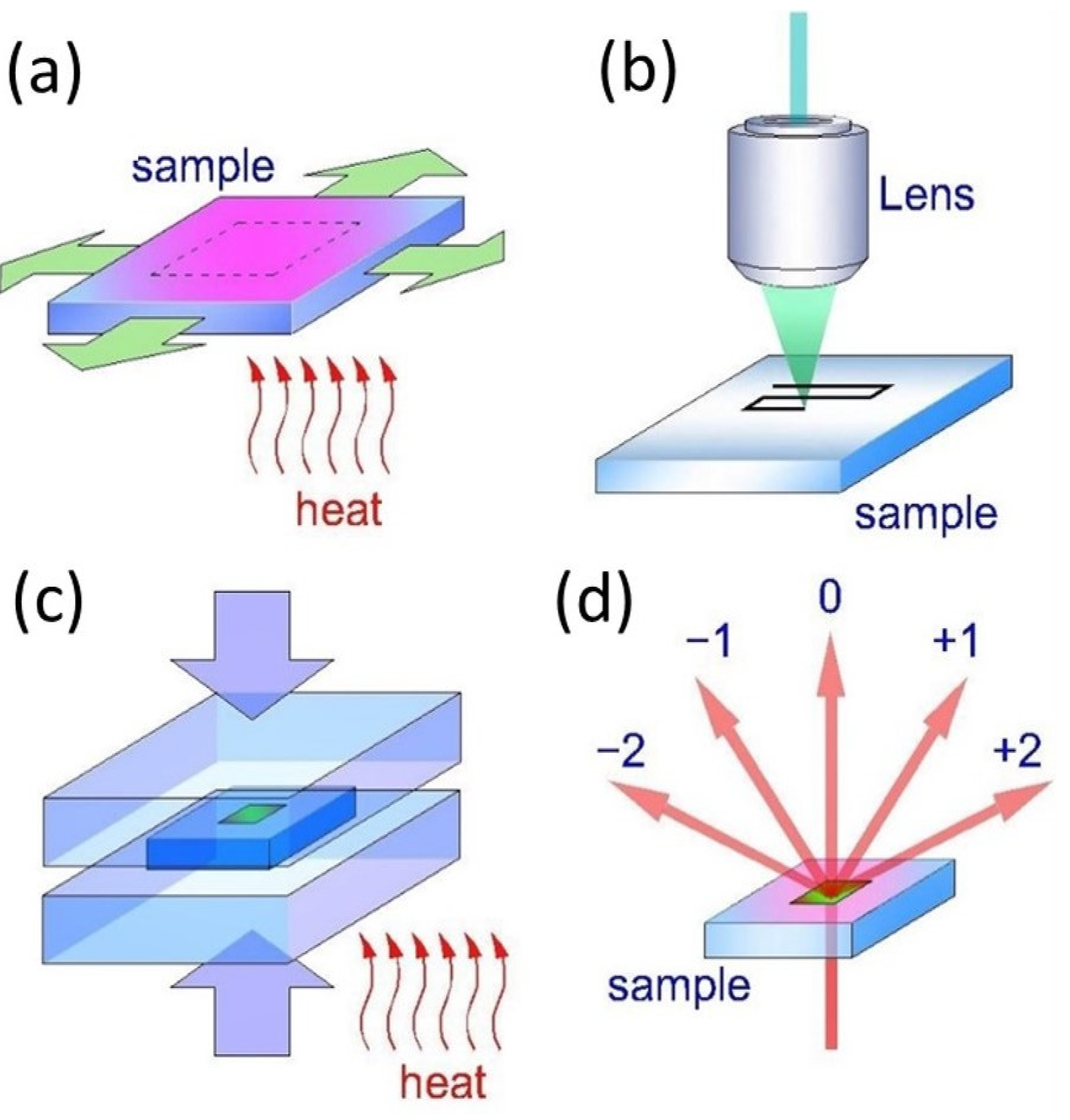
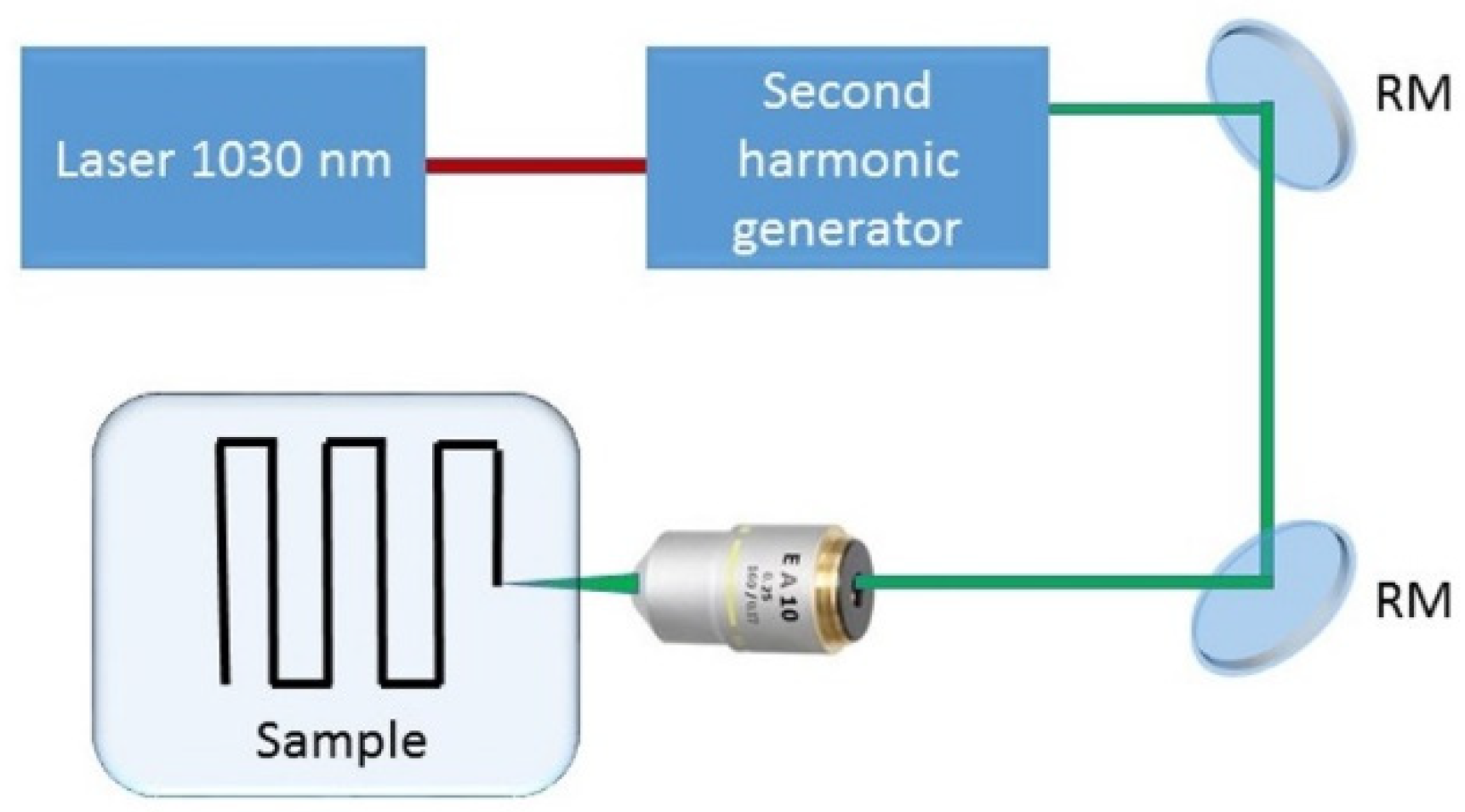
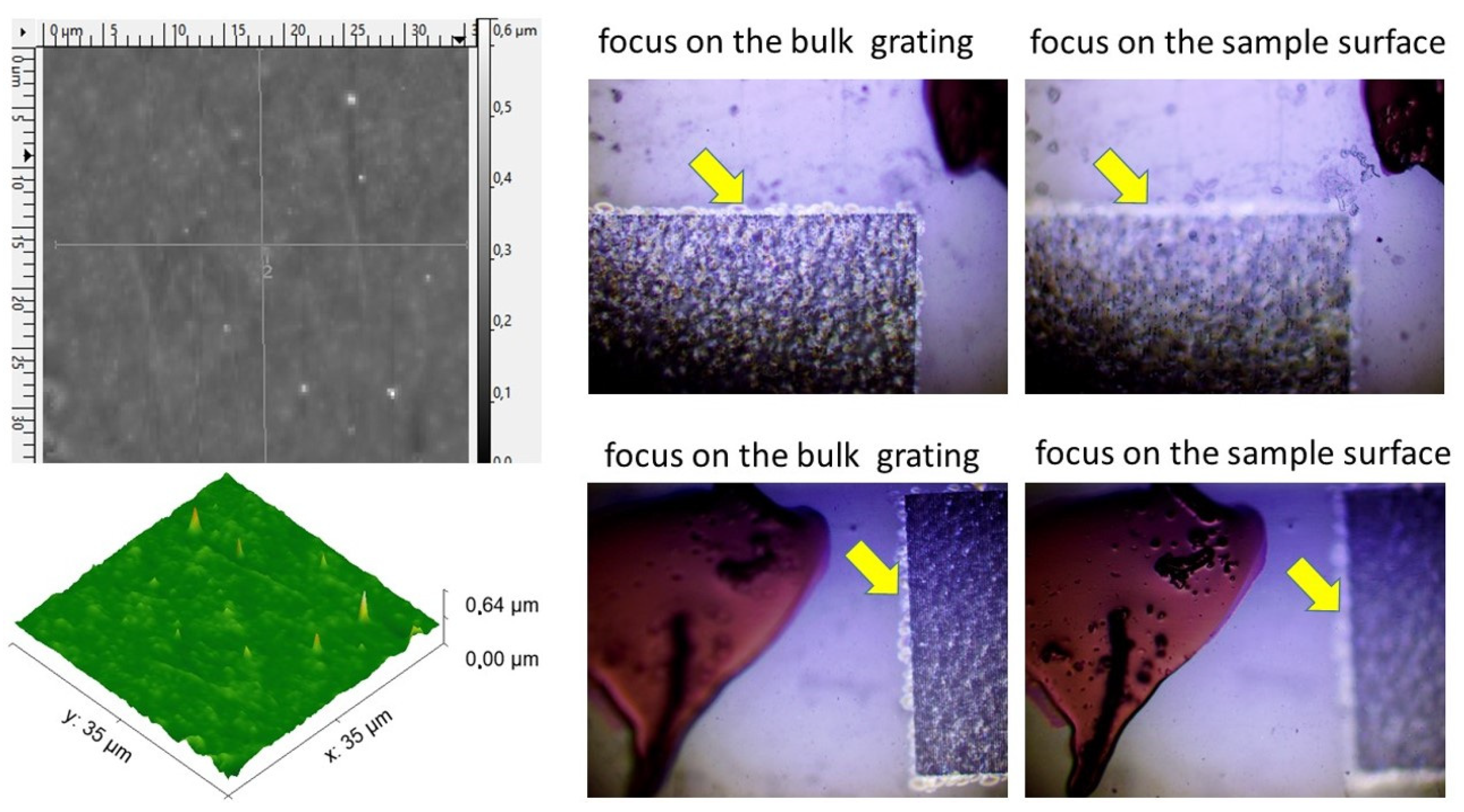


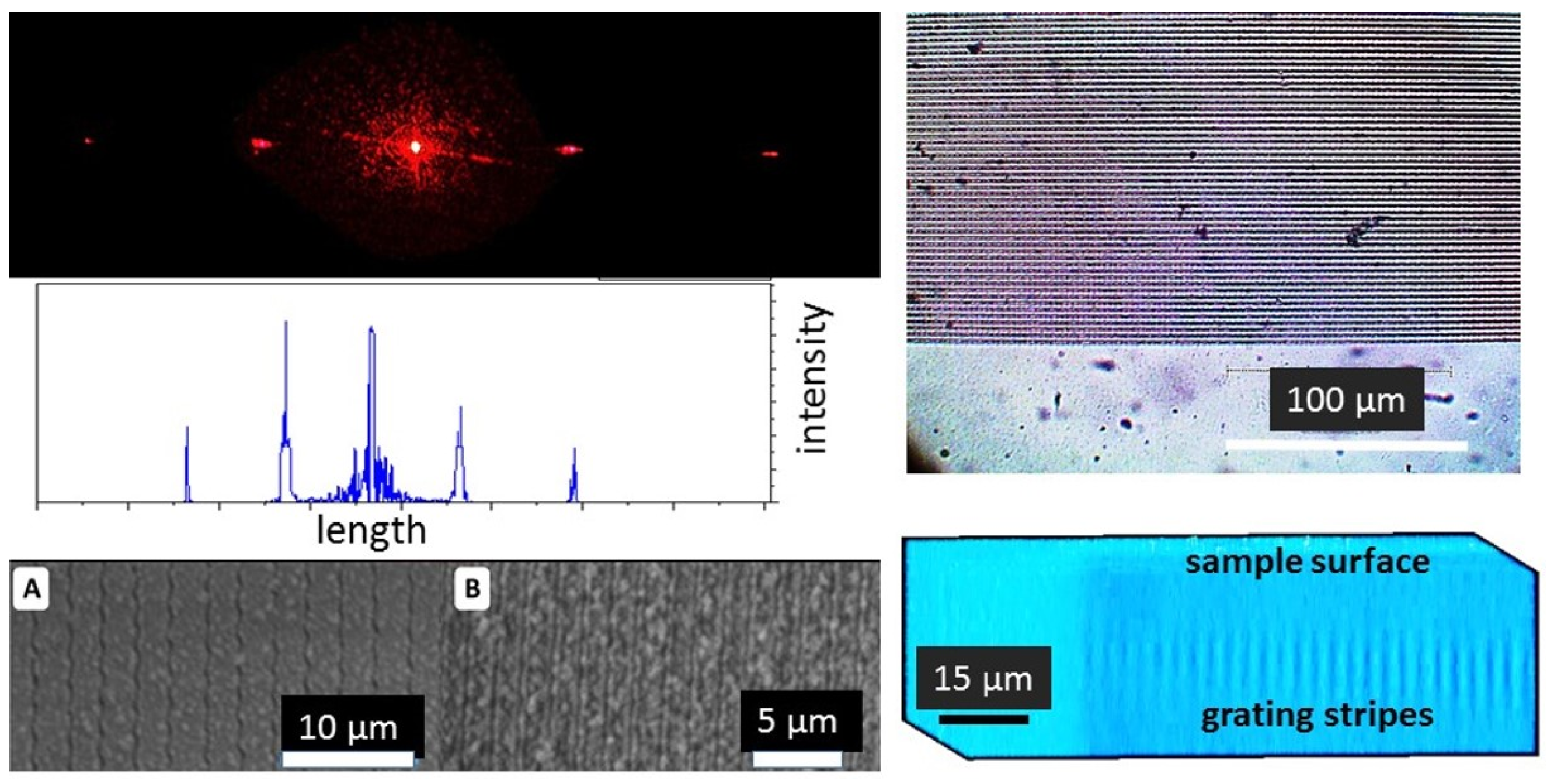

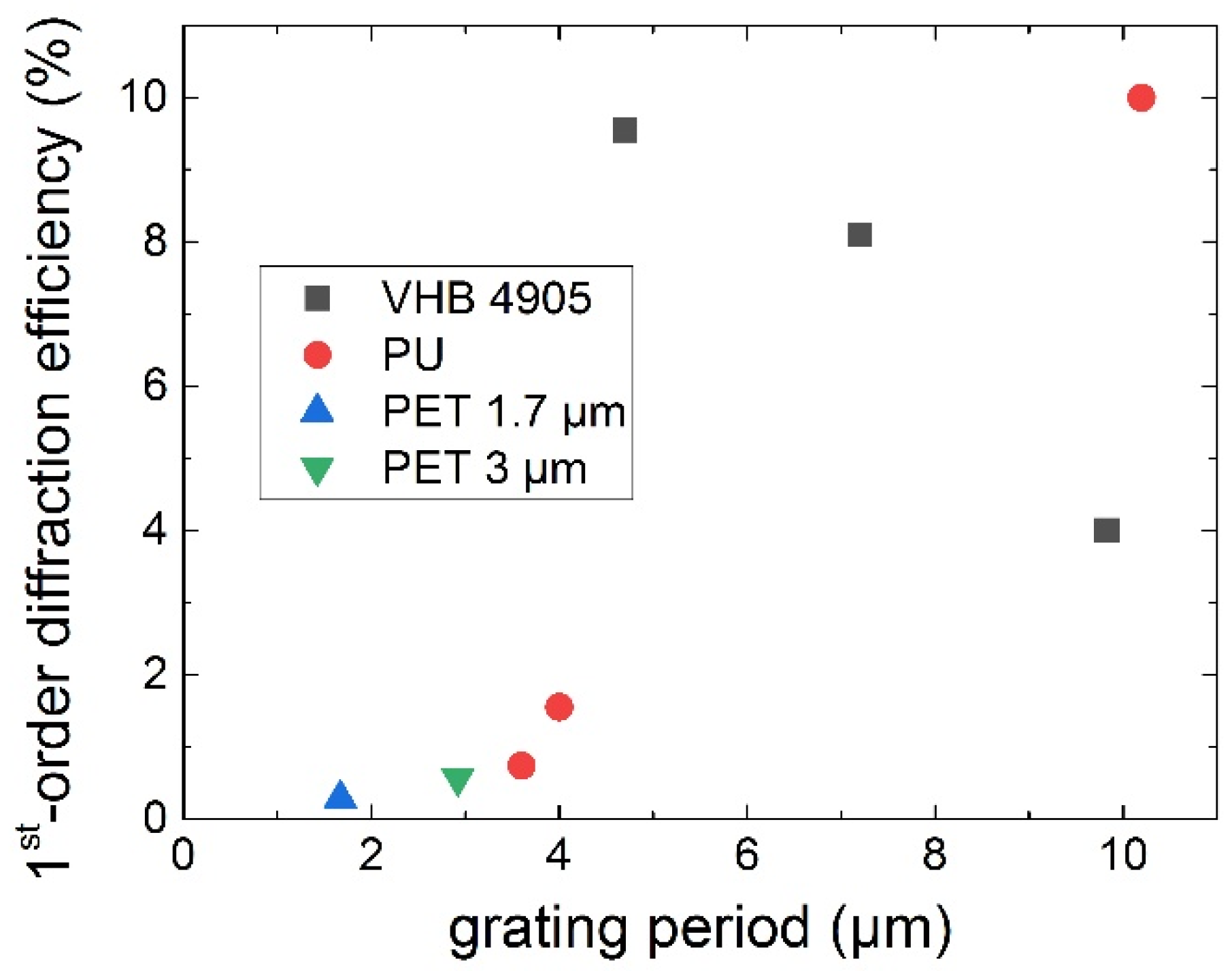


Disclaimer/Publisher’s Note: The statements, opinions and data contained in all publications are solely those of the individual author(s) and contributor(s) and not of MDPI and/or the editor(s). MDPI and/or the editor(s) disclaim responsibility for any injury to people or property resulting from any ideas, methods, instructions or products referred to in the content. |
© 2023 by the authors. Licensee MDPI, Basel, Switzerland. This article is an open access article distributed under the terms and conditions of the Creative Commons Attribution (CC BY) license (https://creativecommons.org/licenses/by/4.0/).
Share and Cite
Kesaev, V.; Rupasov, A.; Smirnov, N.; Pakholchuk, P.; Kudryashov, S.; Odintsova, G. Nanofabrication of Bulk Diffraction Nanogratings via Direct Ultrashort-Pulse Laser Micro-Inscription in Elastomers and Heat-Shrinkable Polymers. Nanomaterials 2023, 13, 1347. https://doi.org/10.3390/nano13081347
Kesaev V, Rupasov A, Smirnov N, Pakholchuk P, Kudryashov S, Odintsova G. Nanofabrication of Bulk Diffraction Nanogratings via Direct Ultrashort-Pulse Laser Micro-Inscription in Elastomers and Heat-Shrinkable Polymers. Nanomaterials. 2023; 13(8):1347. https://doi.org/10.3390/nano13081347
Chicago/Turabian StyleKesaev, Vladimir, Alexey Rupasov, Nikita Smirnov, Petr Pakholchuk, Sergey Kudryashov, and Galina Odintsova. 2023. "Nanofabrication of Bulk Diffraction Nanogratings via Direct Ultrashort-Pulse Laser Micro-Inscription in Elastomers and Heat-Shrinkable Polymers" Nanomaterials 13, no. 8: 1347. https://doi.org/10.3390/nano13081347




